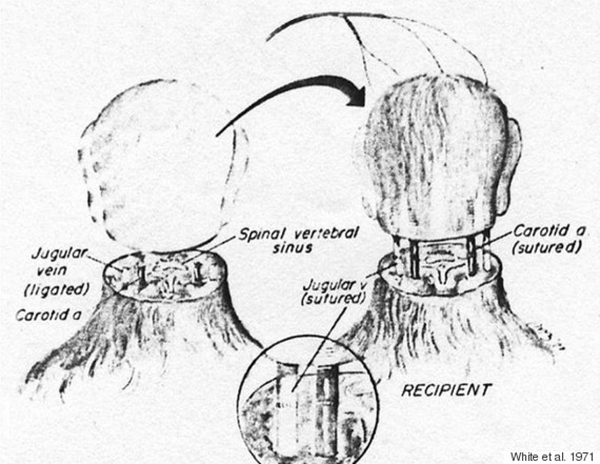First human head transplant may be carried out in 2017 in China
Updated: 2015-09-15 16:25
By Wu Yan(chinadaily.com.cn)
|
|||||||||||
 |
|
In 1970 Dr Robert White transplanted the head of one monkey onto the body of another. |
Has a head transplant been tried before?
No-one has ever attempted a human head transplant before, and attempts on animals have had little success.
The first time a straight swap of heads was "successful", was by Dr Robert White, in an experiment on a rhesus monkey in 1970. However the monkey lived for a mere eight days after the operation.
More recently, Chinese doctor Ren Xiaoping claims to have conducted head transplants on more than 1,000 mice. But none of these mice have lived longer than a few minutes.
What are the challenges involved in a head transplant?
1. The surgery requires the brain to be chilled to 12-15˚C, and only 30-40 percent of brains can survive that.
2. Fusing a spinal cord has never been done before, and may not be possible. This is probably the main objection people have – this hasn't even been attempted on animals, and it sounds hugely unlikely that millions of nerves will be able to connect perfectly.
3. The transplant could be rejected. Immune system rejection occurs when the body sees a new part as foreign and attacks it.
What are the possible side effects of a human head transplant?
If the surgery goes ahead as planned, the most pressing risk is that the body will reject the head and the person will die. Of all the animals this kind of thing has been tried on – monkeys, mice and dogs – the longest any has lived is eight days.
Writing for Forbes, NYU's Dr Arthur Caplan put this matter-of-factly: "I think the most likely result is insanity or severe mental disability."
Related Stories
Chinese surgeon uses 3D printing to map out difficult heart surgery 2015-08-18 16:49
China completes first kidney re-transplant operation 2015-02-04 10:10
Overhauling China's organ transplant system could take some time 2015-01-08 13:48
Mother with womb transplant says risk paid off 2014-10-04 21:29
Lung transplant operation on man, 81, may be world record 2014-08-15 16:10
3D print tech involved in Beijing axis surgery 2014-08-19 13:13
Today's Top News
Cameron urges support for Syrian refugees
Hungary launches border crackdown amid refugee crisis
China, Belgium have great potential in nuclear power generation
China will have 500,000 foreign students by 2020: Vice-Premier
Georgian Prime Minister awarded honorary professorship
Border-free Europe unravels in migrant crisis
Refugee crisis: Germany re-imposes border controls
Australia gets new PM as Abbott loses out to rival Turnbull
Hot Topics
Lunar probe , China growth forecasts, Emission rules get tougher, China seen through 'colored lens', International board,
Editor's Picks

|

|

|

|

|

|






